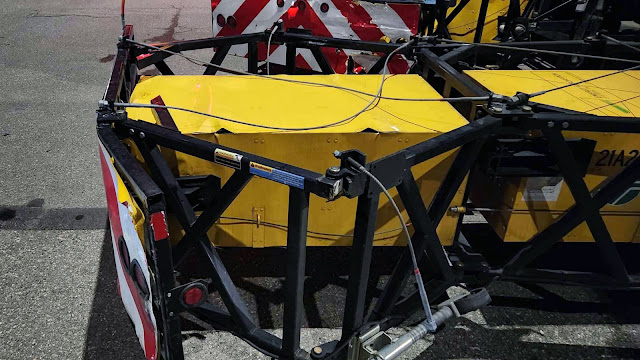By Elizabeth Mount
 |
| Two damaged Road Warriors are next to each other in the maintenance yard after back-to-back work zone collisions on I-5 last year |
Nick Bumgarner uses a lot of tools and experience when planning to keep everyone safe during roadwork. One of the most important – and most impressively named – is the Road Warrior.
Nick is our night crew supervisor in Mount Vernon and has worked with us for 6 years. He knows work zone dangers all too well: In the last year his crew experienced four work zone collisions – two on consecutive nights. Before those four collisions, Nick says since he had been in Mount Vernon there hadn't been any crashes – so it was a frightening series of wake-up calls for the entire crew.
Thankfully no one was seriously injured in the crashes, in large part due to the Road Warriors on the scene. But we can't rely on this protection – we also need drivers to do their part to help keep our crews safe.
So, what is a Road Warrior?
 |
| A Road Warrior is one of the key pieces of equipment our crews rely on to protect them in work zones, the yellow section on the end of the truck absorbs crash impact and protects crews up ahead. |
It's not a worker – though our crews certainly face tough challenges. A Road Warrior is a piece of equipment that helps protect our workers when a vehicle doesn't move over and crashes into a work zone.
Officially called a truck-mounted attenuator, a Road Warrior is a big truck with a large, accordion-like shock absorber on the back. When someone crashes into a Road Warrior, the attenuator absorbs the energy from the crash, lessening the impact and protecting the crews up ahead.
Most work zones have two Road Warriors – one that sets up and takes down cones and barrels and is the last line of defense for our crew doing the work, and a second Road Warrior to protect the first one and warn drivers. Both Road Warriors play a vital role in protecting our workers. If a vehicle hits the Road Warrior, typically the damage and injuries are less severe.
Nick's crew is thankful his team had their Road Warrior out on the nights their work zone was crashed into. Without that piece of equipment who knows what would have happened to our workers?
Four crashes, one crew
 |
| The damage to a Road Warrior from one of the collisions was severe. Thankfully, the attenuator did its job by protecting our crew from being seriously injured. |
Traffic control plans, including advanced warning signs and flashing lights, were in place for each of the four crashes Nick's crew experienced on Interstate 5 last fall and winter. But no plan eliminates all danger – especially with the concerning and erratic driver behavior we've seen in recent years.
In the first crash a driver who said they were falling sleep slammed into the Road Warrior protecting crews clearing drains with a vactor truck, which is essentially a big vacuum.
In the second – the very next night – a driver was on their phone and distracted as they approached the work zone, again striking the Road Warrior as crews finished up work from the evening before.
In the third incident, Nick's crew was sweeping debris and dirt from the median when an erratic driver barreled through the work zone, collided with one of the attenuators and then fled the scene. Washington State Patrol was unable to locate the driver.
The fourth crash, just a few months ago, was while the crew was doing routine maintenance work along the interstate. A driver struck one of the Road Warriors and then kept on driving, though they were later stopped by Washington State Patrol.
In each case the crew had all the required markers, signs and flashing lights giving drivers advanced notice of a crew up ahead. The traffic control plan was reviewed after every crash for any gaps – but each time the review found that every part of the meticulous safety plan had been followed.
The crew was understandably rattled after each crash but they also credit the Road Warrior with saving their lives and preventing serious injuries.
We need your help
Nick has a wife and a young son. Our crews all have families they want to get home to at the end of the day.
Our work zone traffic control plans start with us and end with you – and even Road Warriors can't protect everyone.
Nick's crew doesn't need any more crashes to deal with, they'd rather focus on repairing the road and ensuring everyone makes it home safe at the end of the day. They need your help to do that.
Whenever you're approaching a work zone or see orange cones and vests, we ask you to slow down, stay calm, pay attention and be kind.
Please do your part to keep the road safe; it's a matter of life and death.








